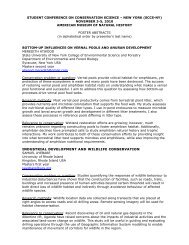SRMP Dynamic Earth Curriculum - American Museum of Natural ...
SRMP Dynamic Earth Curriculum - American Museum of Natural ...
SRMP Dynamic Earth Curriculum - American Museum of Natural ...
You also want an ePaper? Increase the reach of your titles
YUMPU automatically turns print PDFs into web optimized ePapers that Google loves.
Science Research Mentoring Program<strong>Dynamic</strong> <strong>Earth</strong>Session Six: Inner <strong>Earth</strong>TOUR: Arthur Ross Hall <strong>of</strong> MeteoritesTake students to the Ross Hall <strong>of</strong> Meteorites.Start at the Origins section. View and discuss chondritic meteorites. (Note that Renazzo has beenremoved for study.) Explain that they tell us a lot about the early solar system. View the time line <strong>of</strong>the solar system, pointing out formation <strong>of</strong> chondrites and formation <strong>of</strong> planets. View and brieflydiscuss the comparison <strong>of</strong> solar and chondrite chemical compositions.Move to the Planets section. View and discuss each type <strong>of</strong> meteorite:• Stony looks a lot like <strong>Earth</strong> rocks. Compare basalt to meteorites from moon and Vesta. Whichlayer <strong>of</strong> <strong>Earth</strong> does this resemble?• Stony-iron has lots <strong>of</strong> pyroxene and olivine (point out back-lit sample). Which layer <strong>of</strong> <strong>Earth</strong> doesthis resemble?• Iron meteorites have crystalline patterns (Widmanstatten Pattern) not found on <strong>Earth</strong>. Notethat some have different crystal sizes – what does this indicate? Which layer <strong>of</strong> <strong>Earth</strong> does thisresemble?If time allows, look briefly at impacts.If the Ross Hall <strong>of</strong> Meteorites is not available, view samples <strong>of</strong> meteorites (chondrites, stony, stonyiron,and iron) or images <strong>of</strong> meteorites. Students should have a chance to observe meteorites sothat they can compare them (visually) to terrestrial rocks, and to have a better understanding <strong>of</strong> themake-up <strong>of</strong> <strong>Earth</strong>’s inner layers.ACTIVITY: Oxygen Isotope AnalysisThis activity was designed using a set <strong>of</strong> unpublished data. Published data can be found online(example: Table 2 in Origin <strong>of</strong> low-Ca pyroxene in amoeboid olivine aggregates: Evidencefrom oxygen isotopic compositions, by Krot et al. www.sciencedirect.com/science/article/pii/S0016703704007793).Before class: Set up computers. Modify Isotope Analysis Excel file to match data that students willplot, and load the file onto computers. The file can also be modified, depending on how familiarstudents are with Excel. Worksheet will also require modification to correspond with available datasets.During class: Hand out the (modified) worksheet and a data set to students. Remind them that welearn a lot about the inner layers <strong>of</strong> the <strong>Earth</strong> by studying meteorites – especially iron and stonyironones. Explain that the activity will focus on a chondritic meteorite.Read though the introduction as a class. Briefly explain per mil notation. Students should follow theworksheet to plot the data and compare to known parent bodies. Discuss the results as a class.© 2013 <strong>American</strong> <strong>Museum</strong> <strong>of</strong> <strong>Natural</strong> History. All Rights Reserved. 29
















